In today’s competitive hiring market, a talent management system is necessary for every hiring manager about as much as Excel is necessary for an accountant.
So the question isn’t, “Does your human resources team need a talent management system?” Rather, the question is, “Which talent management system best meets your organization’s needs?”
And as you start to compare different talent management software and tools, you’ll quickly come to find that there are different tools for different needs. Often, the best course of action is to develop a good talent management system that relies on different tools, each with its own niche features and benefits.
Starting to build your talent management strategy from scratch? We’ve done the heavy lifting for you — all you have to do is keep scrolling through to learn about our top 12 favorite talent management software.
TL;DR — Key Takeaways
Talent management goes beyond hiring — it’s about finding the right people, assessing their skills properly, and then helping them grow throughout their careers. Using software makes this journey smoother for your whole company.
Talent management systems are an HR cornerstone for hiring teams today. They take care of the hard parts of the hiring process, like keeping track of employment forms, employee engagement, and other strategic initiatives, and make them all more manageable.
The talent management systems we cover include TeamTailor, Deel, Workday, Toggl Hire, Monday.com, BambooHR, Leapsome, Lattice, Remote, Tellent, Paycor, and Breezy.
Skills tests can help optimize and automate pre-employment testing and identify skills gaps in talent management.
Understanding talent management
Talent management in HR refers to the strategic process of acquiring, developing, and retaining the best talent within an organization to achieve its strategic objectives and maintain a competitive advantage. In short, it requires taking a holistic approach to talent acquisition and the continuous career development of employees.
When professionals see growth trajectories and opportunities at work, they’re more likely to be satisfied, engaged, and productive. This can reap multiple rewards for your company, from higher retention to increased innovation and productivity.
An effective talent management strategy can help create seamless role transitions and boost the company’s reputation among top-tier candidates, laying the foundation for long-term success within your team and organization.
What is a talent management system?
Every talent management strategy worth its salt will have a complementary talent management system to help collect, store, and analyze employee data. Using a system is the modern way to streamline and improve your hiring, training, and monitoring of HR and employee performance.
Here are the key elements of a comprehensive talent management solution:
Recruitment and Employee Onboarding
Zeroing in on top candidates and guaranteeing smooth integration
Providing newcomers with resources to adjust quickly
Performance Management
Monitoring individual successes and pinpointing growth areas
Goal-setting and applying regular performance reviews
Learning and Employee Development
Offering complete talent tools designed to improve skills
Supporting a clear path for consistent professional growth
Succession Planning
Identifying potential leadership talent pool within the team
Preparing individuals for bigger responsibilities
Employee Engagement and Feedback
Facilitating transparent dialogue and genuine ongoing feedback channels
Maintaining a driven, engaged, and forward-thinking team
Employee Retention
Prioritizing job satisfaction to maintain a strong team
Addressing any issues to retain employees and prevent top talent loss
Analytics and Reporting
Offering critical metrics to inform decision-making
Generating insights to drive steady progress
Integration with Other HR Systems
Seamlessly connecting with other HR talent management software
Punctual payroll systems and rolling out employee benefits
Compliance and Regulatory Management
Making sure to follow industry standards and regulations through an advanced talent management technology approach
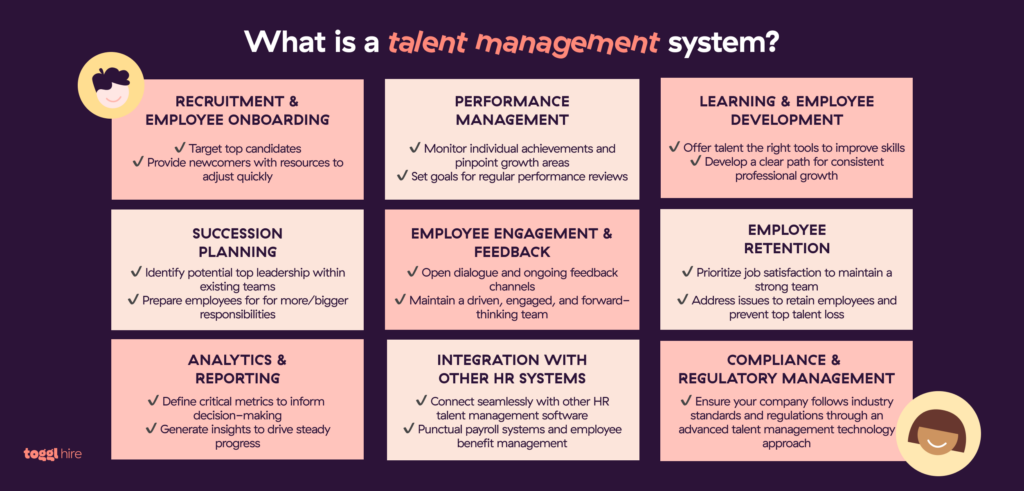
Step-by-step guide to the talent management process
Talent management is a strategic process that includes everything from finding high-performing candidates to selecting the best matches, helping employees grow, retaining them, planning for future talent needs, and ensuring smooth transitions.
This process is crucial for an organization’s success, and that’s why hiring managers need the best talent management evaluation tools to optimize it.
Before we explore each step in detail, here’s a quick overview. Feel free to scan the process and then scroll down for our comparison of the top talent management tools to help you at various stages.
| Planning | Strategic planning for future talent needs |
| Attracting | Actively look for potential high-performers |
| Selecting | Dig deep into candidate evaluations to pinpoint great matches |
| Developing | Roll out personalized growth paths and opportunities |
| Retaining | Captivate your team to keep them engaged and committed |
| Transitioning | Ensuring smooth handovers to protect internal knowledge flow |
Planning
In the succession planning phase, your company should draft a vision. This involves mapping out the essential skills and expertise needed in the future. You also need to spot potential leaders among your current roster and ensure that the new hires’ career plans align with your team goals.
Attracting
During the attracting phase, the spotlight is on outreach. Crafting attention-grabbing job postings and strategically using social media to reach potential candidates. The main goal here is to attract those who will complement your team and help to achieve your larger organizational goals.
Selecting
Selecting goes beyond the typical interview rounds. Use role-specific skills assessments to identify top performers, narrowing down your talent pool to high-caliber applicants only. This ensures each of your hires is an optimal fit for their job responsibilities and for the team.
Developing
Developing is all about career growth, so tailor development plans for each employee for a supportive and educational environment. By offering ongoing opportunities via learning management tools and a path to promotion, you can help your team evolve and adapt.
Retaining
Ongoing recognition is the key to retaining talent. There are many ways to prioritize employee satisfaction, like noticing and rewarding hard work and carrying out strategies to keep your best talent engaged and motivated.
Transitioning
Smooth transitions are important and ensure vital business knowledge doesn’t fall through the cracks as new employees take over important job roles. This part also includes graceful exits, which allow new hires to step into their roles with clarity and confidence.
Top 12 talent management software in 2024
Now that we’ve defined talent management and examined the different steps in the process, we’re ready to explore our picks for the top 12 TMS tools.
1. TeamTailor
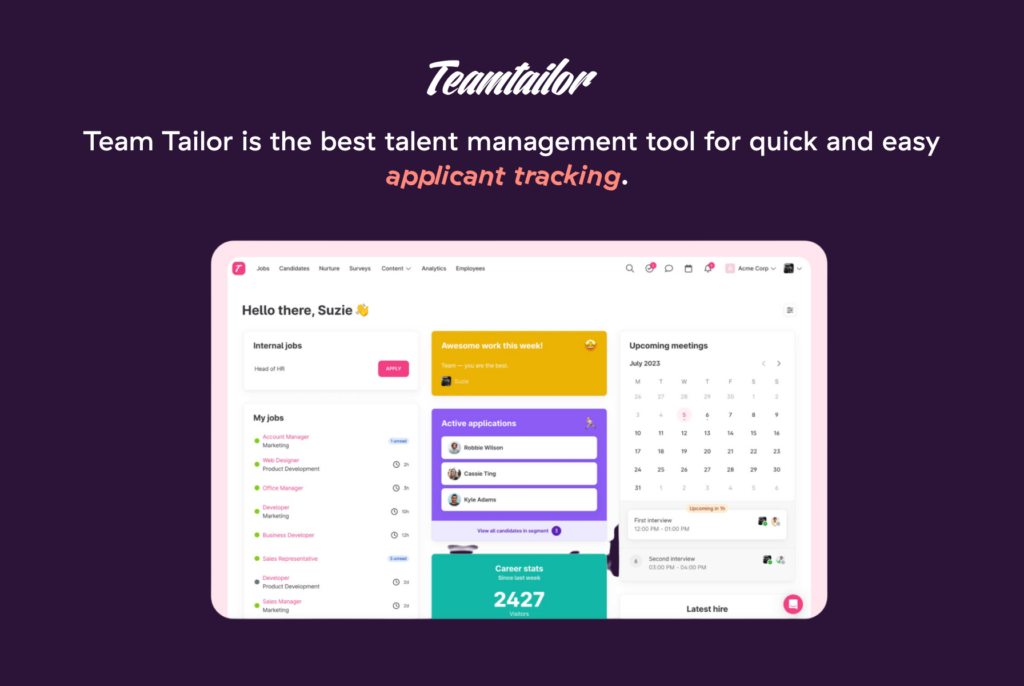
TeamTailor is an applicant tracking system with modern features optimized for your team and candidates in order to hire successfully and efficiently.
👍 Best for quick and easy applicant tracking.
| 🧲 Key Features | 💰 Pricing |
| • Beautiful and simple interface • Candidate database and matching • Advanced search functions • Resumé parser • Job postings to top sites | • Starting from $200/month • Free 14-day trial |
💬 Why Customers Love It
“It is so user friendly. It’s aesthetically pleasing, intuitive and it just makes sense. The support team are incredibly helpful. I love the regular product updates too.” – G2 Review by Ibi E.
Its ease of use and functionality has changed our ways of working and made is so much more collaborative across our hiring team – Capterra Review by Jolene V.
2. Deel
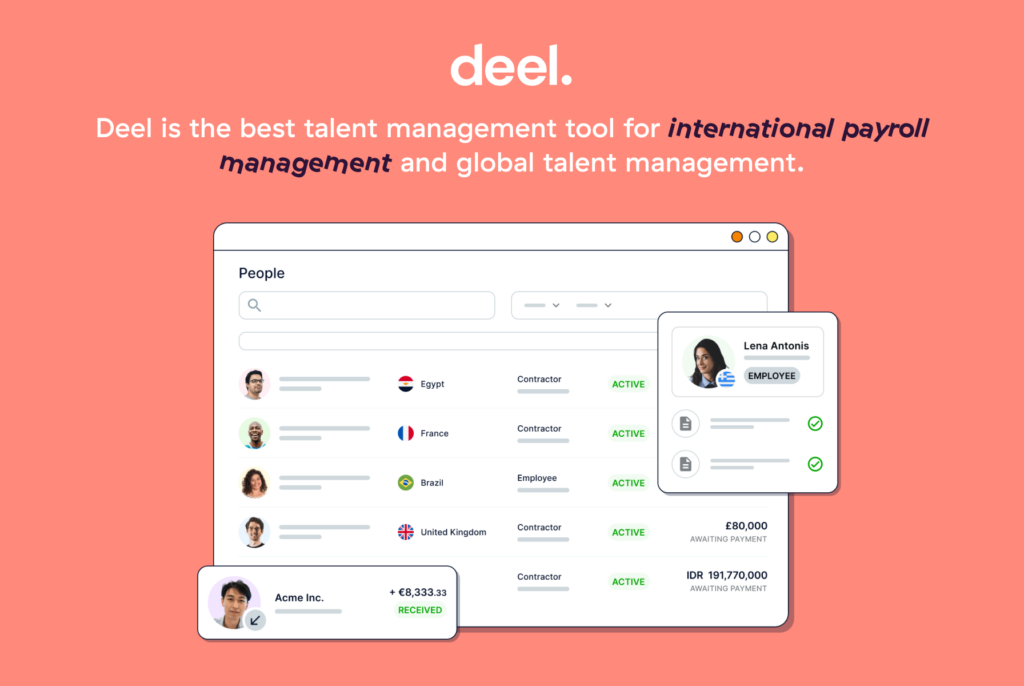
Deel is a tool designed for global teams. It provides the essentials, from onboarding international employees to handling their local compensation management and compliance. It supports both contractors and full-time staff in more than 150 countries.
👍 Best for managing talents and teams globally.
| 🧲 Key Features | 💰 Pricing |
| • Intuitive interface • Tailored for international payroll management • Works with multiple currencies • Automated compliance document management • Real-time candidate tracking • Streamlined invoice management system | • Starting at $49/month • Free version available |
💬 Why Customers Love It
“What I really appreciate about Deel are a few key things. First, their speed – they’re on the ball, making things efficient and hassle-free. Second, their pricing is fair and reasonable, which is a big thumbs up for freelancers like me.” – G2 Review by Glenn P
“It is clear and user friendly, it has all the info that you need and it is super fast and on time always! International tansfers can be hard to manage but Deel makes it amazingly easy!” – Capterra Review by Yoselyn Z.
3. Workday
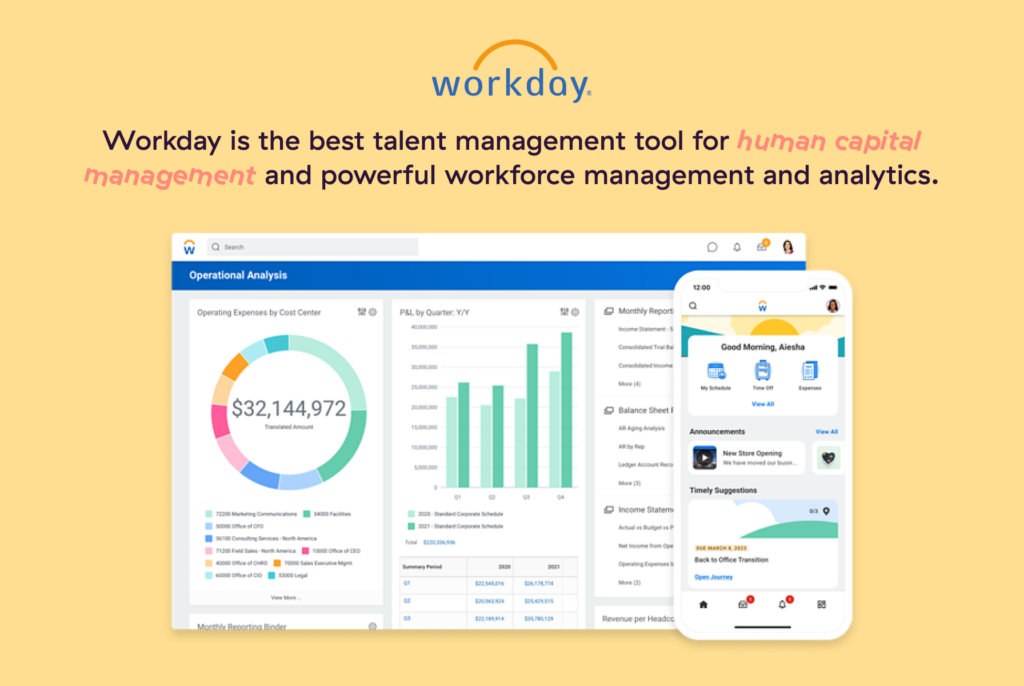
Workday is a cloud-based software built on AI and machine learning. It focuses on managing your company’s finances, enterprise resources, and your team effectively.
👍 Best for human capital management with powerful workforce management and analytics.
| 🧲 Key Features | 💰 Pricing |
| • Analytics and reporting • Employee self-service platform (with mobile access) • Test workflow before putting it in action for your team • Remote check-in and time tracking • Full employee lifecycle management | • Starting at $99/month (according to users) • Custom quotes are available based on your needs |
💬 Why Customers Love It
“My favorite aspect of Workday is the User Interface. The software is very easy to navigate for any user, and requires almost no training. I also love the personnel reports I can pull through Workday with our HRIS specialist.” – Capterra Review by John J.
“The best thing about the Workday application is that it’s user friendly and simple, it does the work quickly in minutes. We use it to mark our leaves and it is very useful and simple.” – G2 Review by James D.
4. Toggl Hire

Toggl Hire is a skills assessment platform that cuts down hiring time by 80%. It helps hiring teams pinpoint the most qualified best talent for the job, with a job test library of 150+ assessment templates.
👍 Best for skills assessment and identifying top performers.
| 🧲 Key Features | 💰 Pricing |
| • Easily navigable interface • Laser-focused skills testing • Role-specific assessment flow • Automated candidate screening • Candidate relationship management | • Starting at $49/month • Free version available |
💬 Why Customers Love It
“Great help for recruitment — intuitive, very easy to navigate through the platform — templates with automatic links- possibility to personalize.” – Capterra Review by Paulina
“I simply love Toggl Hire! The interface is beautiful and the user experience is super! It’s also very agile and I can make out its because Toggl is known for their remote monitoring expertise way before Covid!” – G2 Review by Anupama K.
5. Monday.com
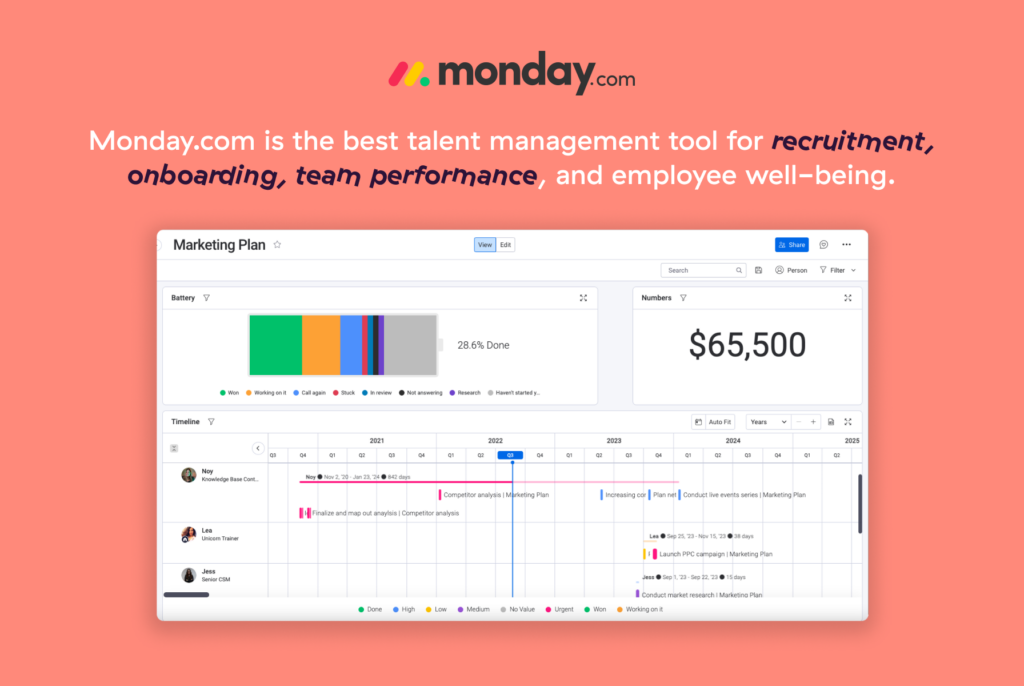
Monday.com is an employee management system that gives a clear view of project timelines, monitors the talent pipeline, and keeps your team engaged.
👍 Best for recruitment, onboarding, team performance, and employee wellbeing.
| 🧲 Key Features | 💰 Pricing |
| • Workflow customization and automation • Project management and tracking • 100s of templates to streamline workflow • Team engagement surveys • Benefits administration | • Starting at $8/month for teams • Free trial available |
💬 Why Customers Love It
“The platform is completely customizable, and we are able to use it for every different department in our company. We haven’t even fully unlocked its true potential, but it’s made our workflow so much easier to manage!” – G2 Review by Ryan U.
“Monday has revolutionized the way our team manages projects and workflows, providing a comprehensive platform that fosters collaboration, organization, and efficiency. From task tracking to communication, the software’s array of features has greatly improved our productivity.” – G2 Review by Briana B.
6. BambooHR
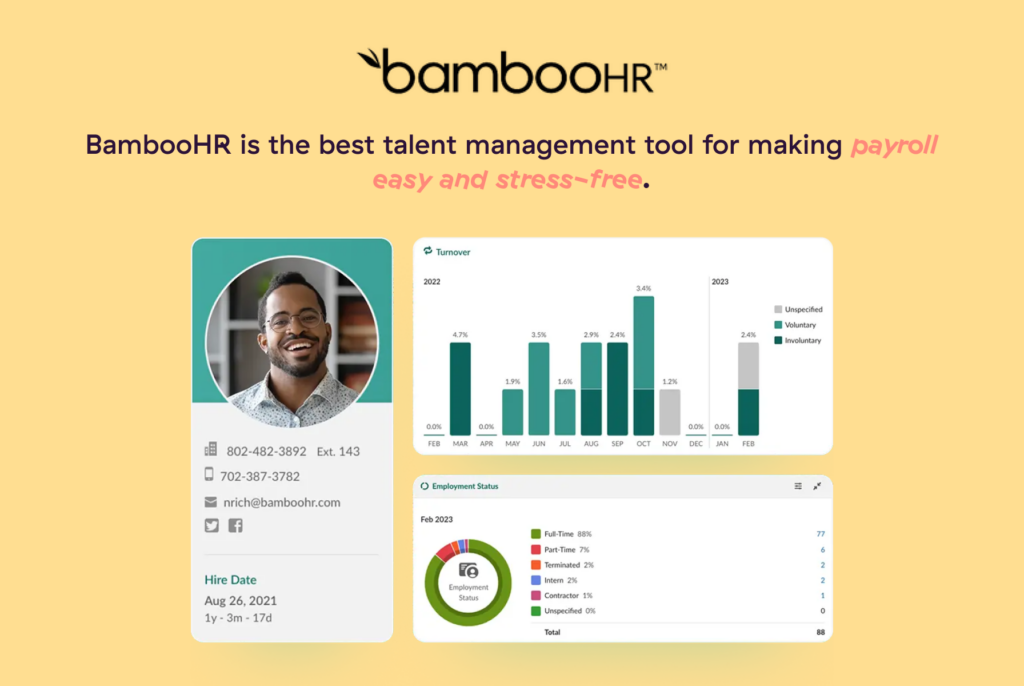
BambooHR is a multi-purpose software with user-friendly navigation. It’s your all-in-one human resources toolkit where employees and managers track goals and performance on a nearly daily basis.
👍 Best for making your payroll easy and stress-free.
| 🧲 Key Features | 💰 Pricing |
| • Applicant tracking system • Benefits management • Employee onboarding • Time-off tracking • Simplified payroll management tools | • Starting at $5.95/month • Free trial available |
💬 Why Customers Love It
“It is our single source of truth for all things HR – we can direct employees to access their resources, and it’s a great recruitment tool. We are able to integrate our paystubs, benefits and can upload important documents like policies.” – G2 Review by Kam B.
Its ease of use both from a HR perspective and from the staff perspective. Noboby, regardless of their computer skills has ever had an issue with it. – G2 Review by Lorraine B
7. Leapsome
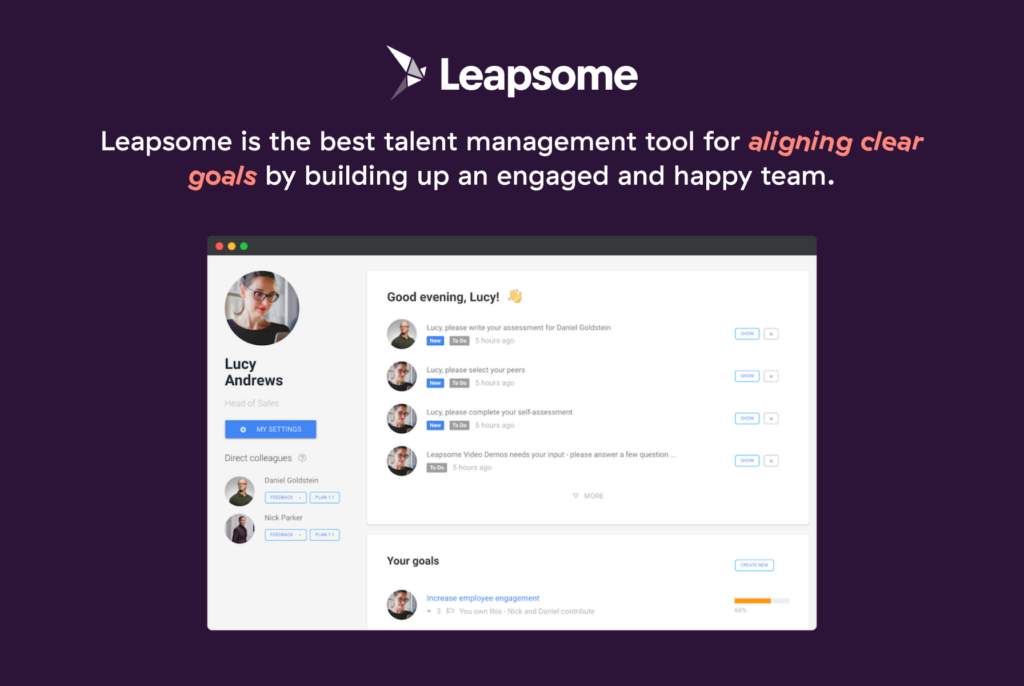
Leapsome focuses on a clear and user-friendly experience while boosting employee performance, professional development, and engagement. It simplifies tasks like offering feedback and setting organizational goals — making your job a bit easier.
👍 Best for aligning clear goals by building up an engaged and happy team.
| 🧲 Key Features | 💰 Pricing |
| • Goal and challenge creation and tracking • Performance management • Continuous feedback • Customizable forms • Workflow automation | • Starting at $8/month per user with annual billing • Custom quotes are available by request • Free trial available |
💬 Why Customers Love It
“Leapsome provides a holistic platform that encourages praise and constructive feedback in a way that integrates with meetings, reviews and goal setting.” – G2 Review by Ian B.
“Enables us to do 360 ° feedback, which was very valuable, and cover a few other areas – We had a smooth sales and onboarding process to Leapsome – Combining learning and OKRs is a good value proposition to us.” – Capterra Review by Verified LI user
8. Lattice
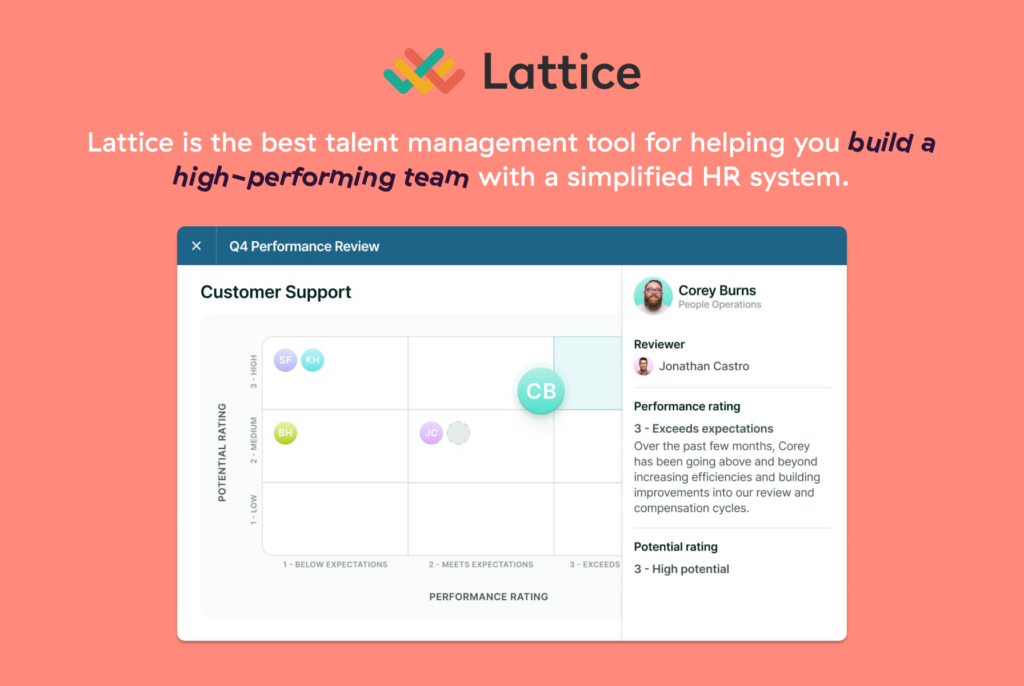
Lattice improves team collaboration and simplifies progress tracking. Thanks to its clear focus on shared goals, it’s a favorite for many teams.
👍 Best for helping you build a high-performing team with a simplified HR system.
| 🧲 Key Features | 💰 Pricing |
| • Peer recognition • Data-driven analytics • Customization and personalization • Individual and team goal setting and tracking • Seamless integrations • 1:1 meetings | • Starting at $4/month • Free trial available |
💬 Why Customers Love It
“I’ve been very happy with Lattice and our implementation. We needed a tool for 1:1s, goals, and performance reviews, I feel very happy with the results in our short time. I look forward to what our future holds.” – G2 Review by Amber L.
“Lattice makes people leadership easy and enjoyable – the feedback and 1×1 features have been so useful to streamlining management while still maintaining an individualized, personal approach. I use it daily!” – G2 Review by Kelsey A.
9. Remote
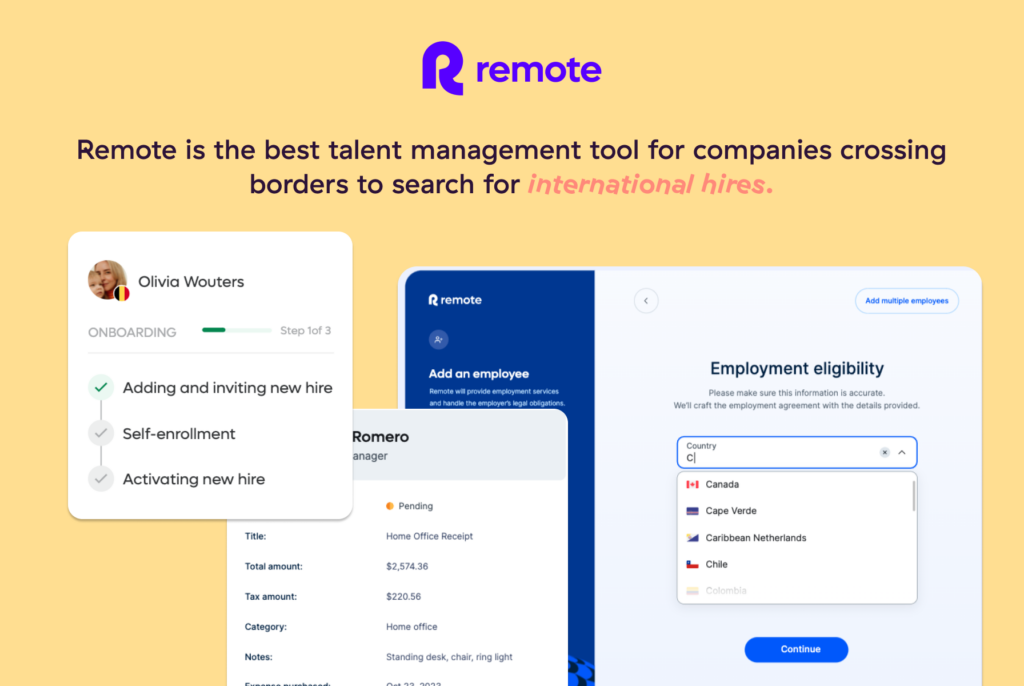
Remote is a powerful and straightforward platform for global onboarding with top-tier security, ensuring your team’s information stays protected.
👍 Best for border-crossing searches for international hires.
| 🧲 Key Features | 💰 Pricing |
| • Automatic tax payment • Multi-country processing • Benefits management • Employee self-service • Payroll entry | • Starting at $599/year • $29/month per international contractor • Free 30-day trial available |
💬 Why Customers Love It
“The app is super fast, easy to use, helps you organize your documents and everything related to you relation with your final company.” – G2 Review by Verified user
“Remote made it simple – one stop for all documents, time on and off, pay slips.” – G2 Review by Tomislav P.
10. Tellent
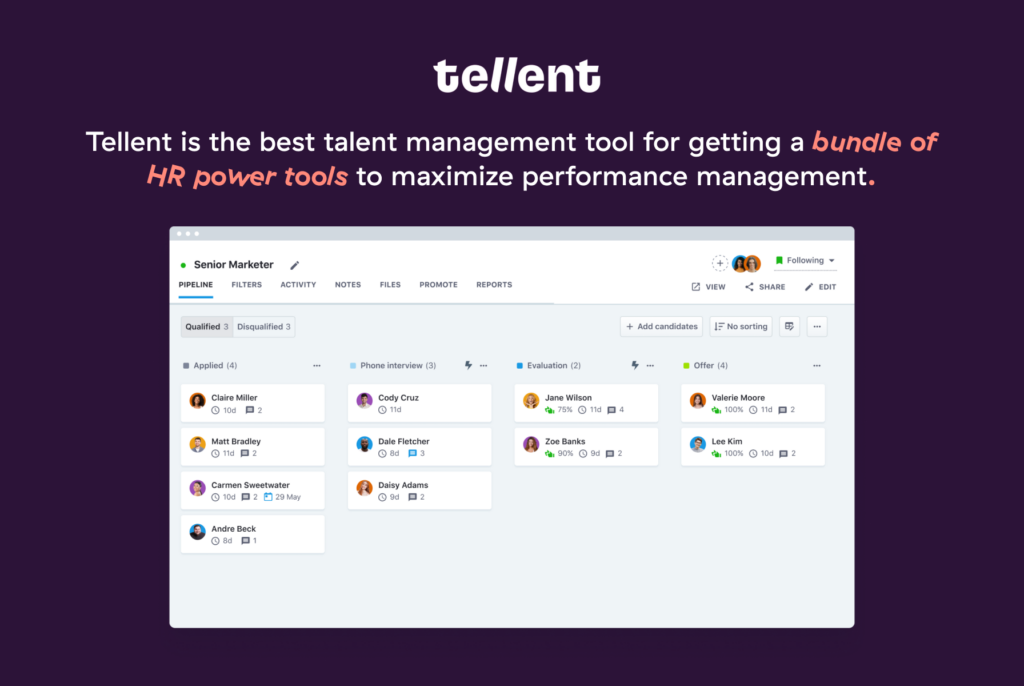
Tellent combines three powerful talent management software systems: Recruitee for tracking applicants, KiwiHR for managing employee data, and Javelo for performance management. It’s a unified suite designed to enhance the entire employee lifecycle.
👍 Best for getting a bundle of HR power tools to maximize performance management.
| 🧲 Key Features | 💰 Pricing |
| • Triad of talent management software: hire, manage, retain • Seamless operation between platforms • 360° feedback • CoreHR • Job posting to multiple platforms and social media | • Custom pricing based on your HR needs • Free trial available |
💬 Why Customers Love It
I regularly received feedback from hiring managers and candidates, advising that it’s easy to use, functional, and provides a tremendous navigable experience. The system is set up to allow managers to collaborate on hires through various features. – G2 Review by Jade J.
Simplicity, ease of use, user-friendly UI. – G2 Review by Verified user
11. Paycor
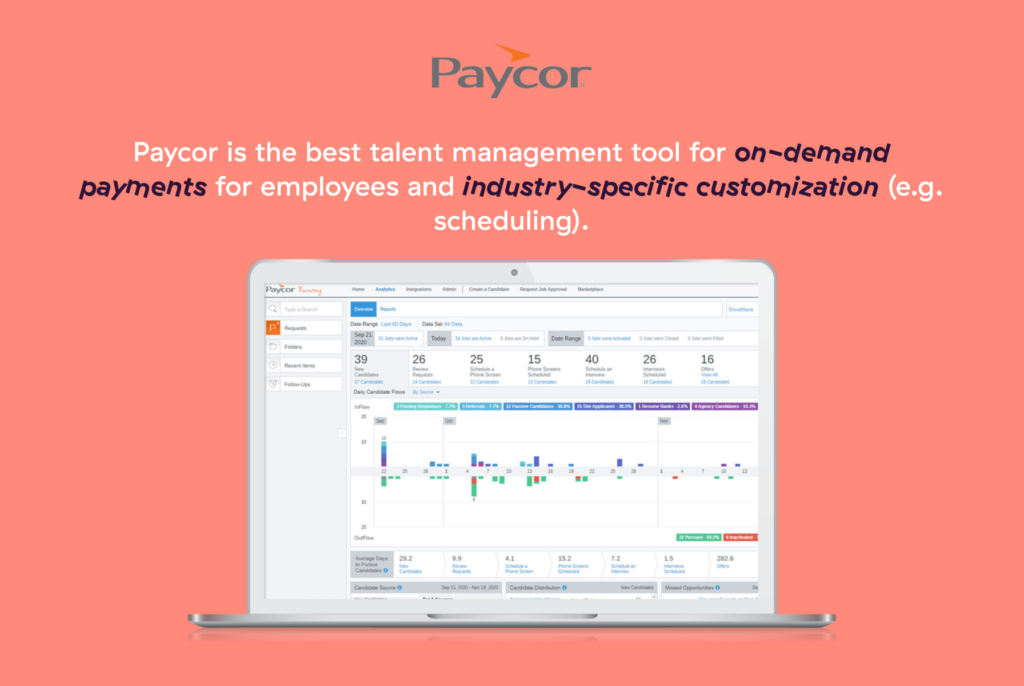
Instead of a one-size-fits-all approach, Paycor stands out for delivering solutions designed for the unique requirements of your sector, employee base, and work setting. It covers just about every aspect of a business’s HR and payroll needs.
👍 Best for on-demand payments for employees and industry-specific customization (e.g., scheduling).
| 🧲 Key Features | 💰 Pricing |
| • Solutions for specific industries • On-demand payroll management • Open enrollment portal for benefits administration • Tax filing • A high degree of automation | • Starting at $99/month • Free trial available |
💬 Why Customers Love It
I LOVE the Applicant Tracking System. It has reduced time to hire and made it so easy to quickly check where we are with each position. Payroll is very easy as well. – G2 Review by Courtney H.
PayCor has an answer for all of my employment requirements from recruiting to retirement. I can pick and choose the types of modules I need. Their implementation process is thorough, their follow up is consistent and their people are always helpful and kind. – G2 Review by Catherine H.
12. Breezy
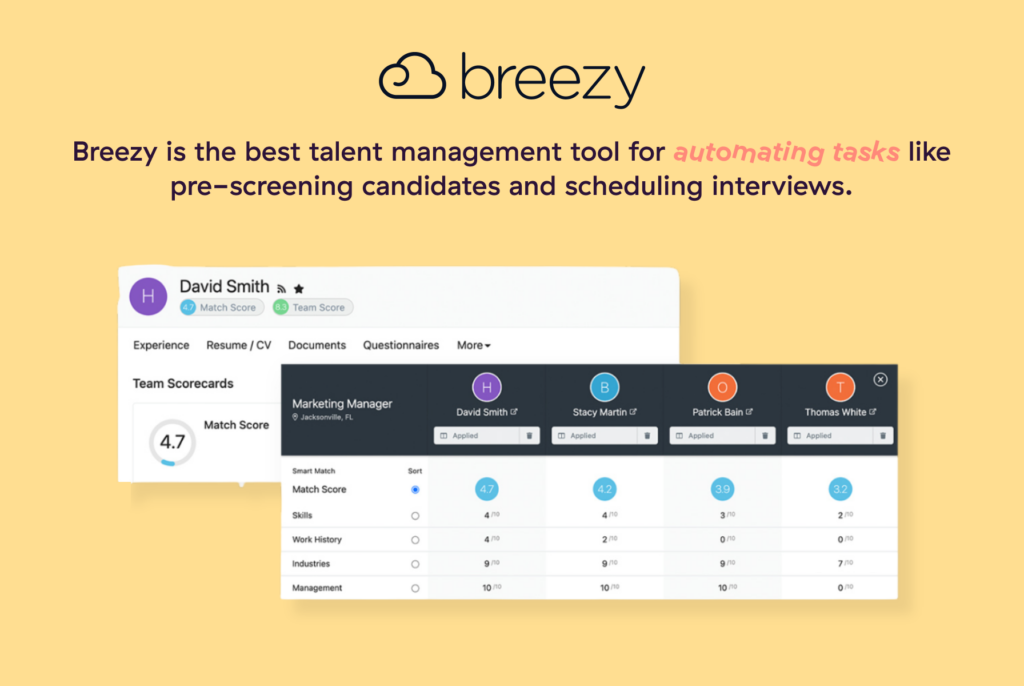
Breezy is a modern hiring tool that makes the whole process, well, breezy. It handles tasks from job posting to interview scheduling and provides a Candidate Match Score. Designed for simplicity, it ensures your entire team can engage without a hitch.
👍 Best for automating tasks like pre-screening candidates to scheduling.
| 🧲 Key Features | 💰 Pricing |
| • Unbiased candidate scorecards • Team collaboration in hiring • Fun to use • Seamless integrations • Automation for job listings | • Starting at $157/month • Free version available |
💬 Why Customers Love It
“I love that it is incredibly easy to create templates, which makes it very easy for us to communicate directly with applicants in a timely fashion. It is incredible!” – G2 Review by Natalia G.
“BreezyHR is a game-changer in HR software. Its user-friendly interface, comprehensive features, and excellent customer support make it a top choice for organizations looking to streamline their recruitment process. Highly recommended!” – G2 Review by Raja Faheem
Boost your talent management strategy
As these tools are changing all the time, it’s important to stay up-to-date with the latest talent management software to ensure you have the right digital toolkit for simplifying your HR tasks.
By automating your mundane routine tasks, these tools will free up valuable time, allowing you to focus on the best part of your job (the human side) while helping you steer successfully into the future of HR.
To help you navigate the talent management solution maze, here’s a pro tip that will push your human resources ahead of the curve! 👇
Browse the Toggl Hire Test Library, a tool built by experts for tomorrow’s talent challenges. We know you’re 100% committed to finding the best talent, so go ahead and start here.
Elizabeth is an experienced entrepreneur, writer, and content marketer. She has nine years of experience helping grow businesses, including two of her own, and shares Toggl's mission of challenging traditional beliefs about what building a successful business looks like.





![10 Best Team Management Software [2024]](https://toggl.com/blog/wp-content/uploads/2023/12/top-team-management-software-112x67.jpg)









